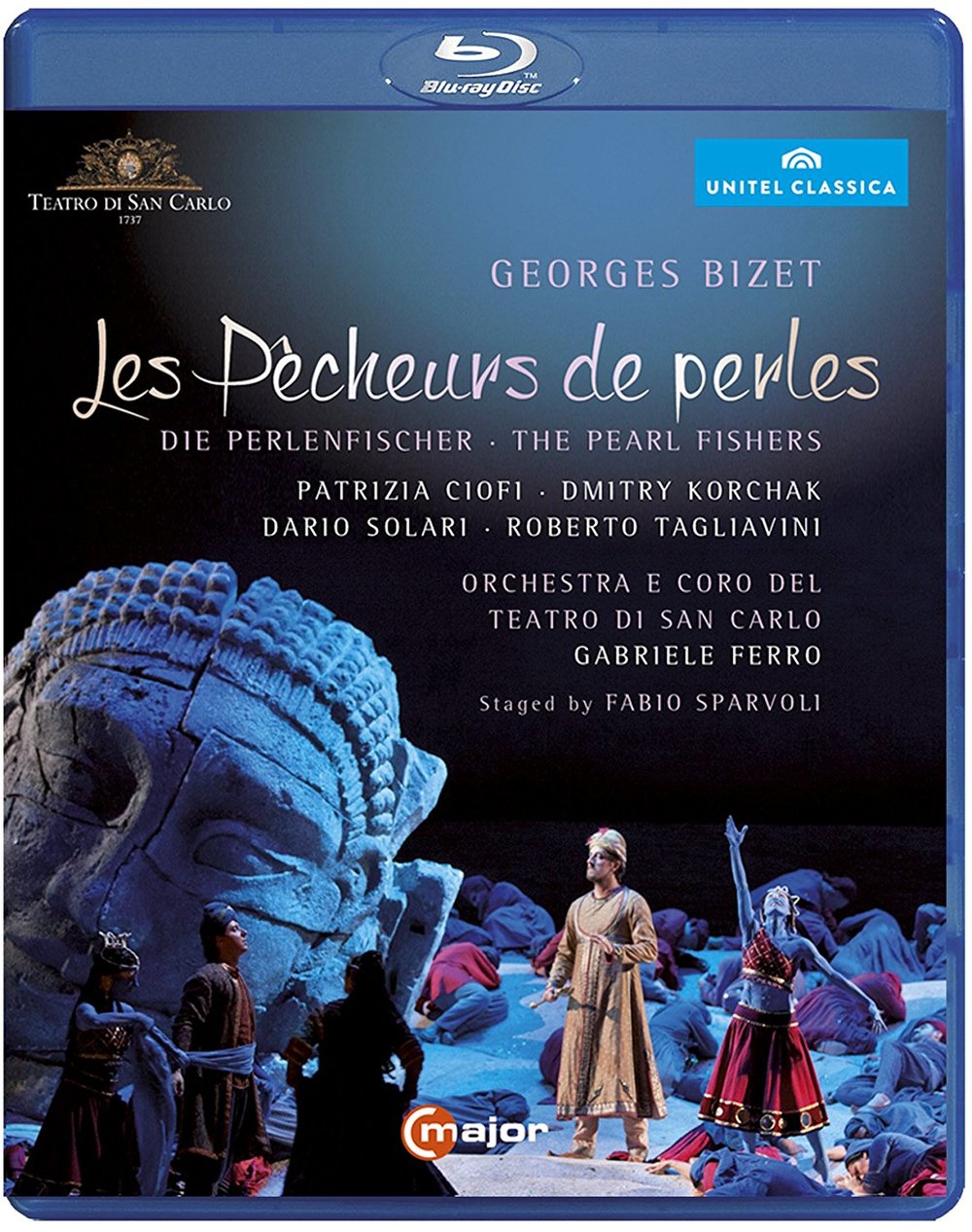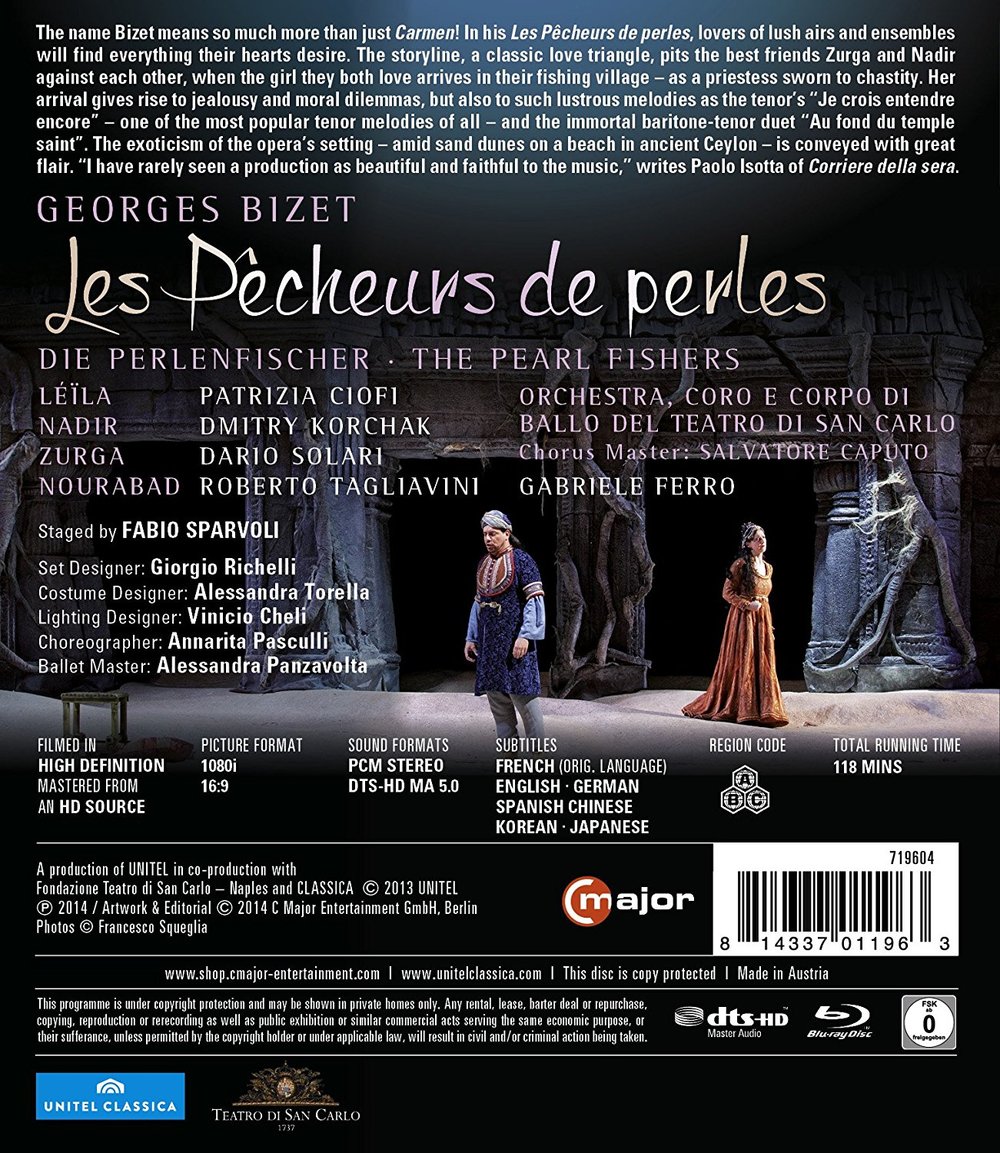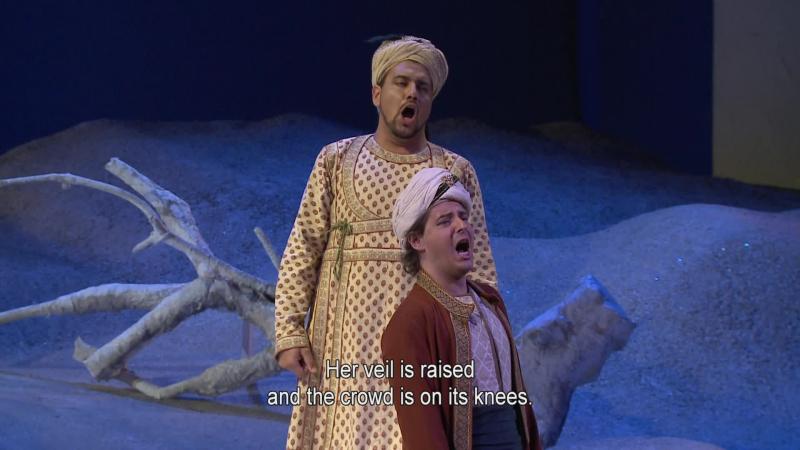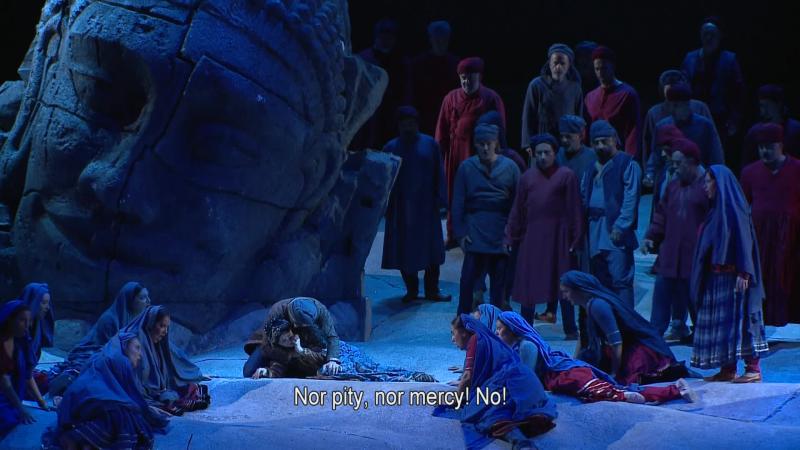

Bizet Les pêcheurs de perles opera to libretto by Eugène Cormon and Michel Carré. Directed 2012 by Fabio Sparvoli at the Teatro di San Carlo. Stars Patrizia Ciofi (Léïla, a priestess), Dmitry Korchak (Nadir, a hunter), Dario Solari (Zurga, elected chief of the pearl fishers), and Roberto Tagliavini (Nourabad, the high priest). Gabriele Ferro conducts the Orchestra, Chorus, and Ballet Corps of the Teatro di San Carlo (Chorus Master Salvatori Caputo). Sets by Giorgio Richelli; costume design by Alessandra Torella; lighting design by Vinicio Cheli; choreography by Annarita Pasculli with Ballet Director Alessandra Panzavolta. Directed for TV by Davide Mancini; high-definition editing by Tiziano Mancini and Mauro Santini; produced by Thomas Hieber. Sung in French. Released 2014, disc has 5.1 dts-HD Master Audio sound. Grade: B-
There are two versions of Les pêcheurs de perles available now in HDVD: the "gritty" 2016 update directed by Penny Woolcock at the Met and this "pretty" version staged in 2012 at the Teatro di San Carlo in Naples. If you insist on a traditional version of Les pêcheurs, then the Naples show directed by Fabio Sparvoli is your only choice.
But if you try to compare the Met and the Naples productions in any other way, why, it's just not a fair fight. The Met is the maybe the strongest opera house in the world, while the Teatro di San Carlo (oldest opera operation in the world) is now part of the Italian opera backwater with this and only one other Blu-ray recording to its credit. The Met probably spent more money on those aerialists diving during their Les pêcheurs overture than Fabio Sparvoli in Naples had in his whole budget. In the opening scene below the entire set consists of a lumpy "beach" full of holes and cracks that is as unpleasant to see as it must have been for the singers and dancers to negotiate. Oh! There is one prop—a piece of driftwood says "Beach!"
Next below the villagers elect Zurga (Dario Solari) as King. The cheap costumes don't look very exotic to me. They look like they have been washed 1000 times after 1000 other shows:
Thank Goodness, the lead singers are all capable. Here we see Nadir, the hunter, (Dmitry Korchak):
To try to give this some visual interest, dancers are constantly about. To me they appear to be community volunteers or semi-pro folk mostly doing this as a lark. This maybe could work, but they needed more (a lot more, really) rehearsal and detailed personal direction:
The Italian orchestra could not be favorably compared to the musicians at the Met, but you get what they are trying to do. Bizet's music here is so immediately and completely arresting and beautiful that one can still enjoy this production even with all the deficiencies noted:
A near-shot of dancers:
The mysterious priestess takes her oath of office:
Now we see Léïla (Patrizia Ciofi) unveiled. The lovers find each other in the night through their furtive calls of love in the dark. This was effective although I would have to say that the personal direction shown here seems pretty inept to me:
The ruined statute is effective even with all those cracks:
Surely the San Carlo folks could have found a younger girl in Italy to do this. But once you accept your fate, Patrizia Ciofi manages quite well even with a couple of harsh high notes. Here you see the cheap looking necklace that proves to be important later:
Caught in flagrante delicto:
Zurga condemns the lovers:
Writing in the 2015 March Gramophone (page 90) Mike Ashman shows little enthusiasm for this "less than sharp revival" and "predictable-looking traditional production" with a weak chorus and "rather unfit-looking dancers." But our own discerning critic, John Aitken, gave us a happier report:
“I enjoyed this performance very much. The trio of principal singers are all very good indeed, and the production is charming. Anyone wanting to try out Bizet's "other" opera will be happy with this production and find much to enjoy from the singing. The dancing is perhaps a bit weak, but this does not detract from the whole. The old-fashioned style of presentation suits the piece; all in all, this is a very enjoyable issue.”
We will add that even with our criticism and obvious bias in favor of the Met version, we enjoyed the music and the story told here by the 4 main singers, the chorus, and the orchestra. Les pêcheurs de perles is like a hardy diver who can bring back pearls even after being smashed against rocks by waves, attacked by sharks, and tumbled by rip-tides.
OR














